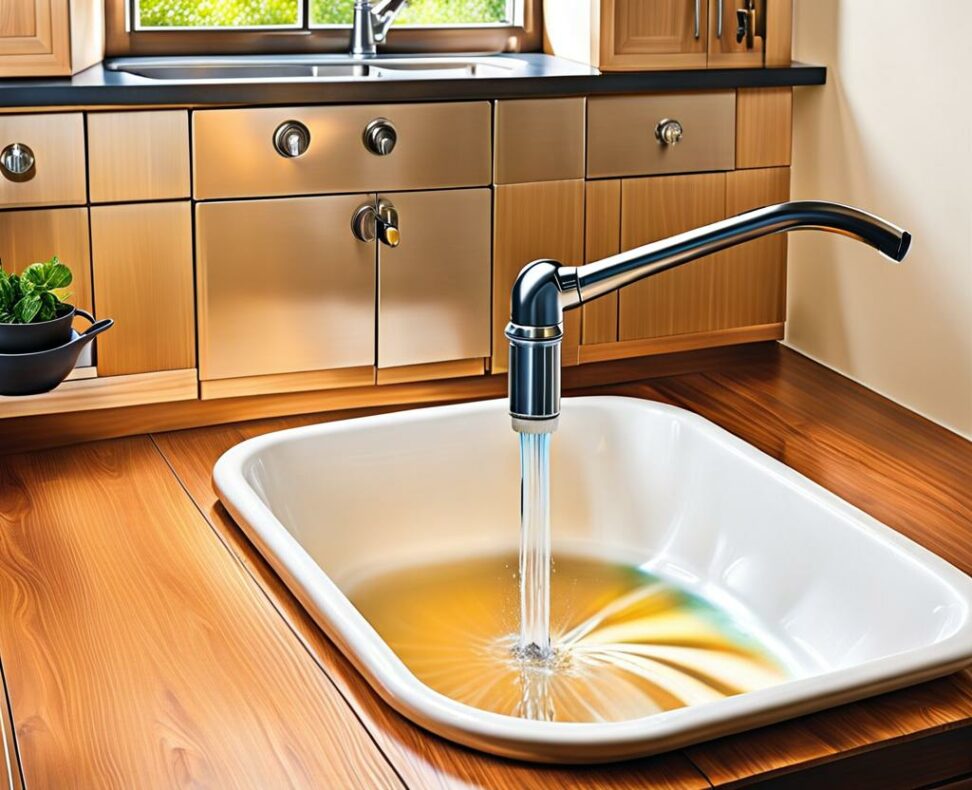Low Kitchen Sink Water Pressure? How to Troubleshoot and Boost Flow Now
It's incredibly frustrating when the water pressure at your kitchen sink drops to a slow trickle. Whether it's taking forever to rinse dishes or not being able to properly wash vegetables, low water flow can make preparing meals a hassle.
Fortunately, there are several common causes of decreased kitchen sink pressure that you can troubleshoot yourself. With some simple DIY diagnostics and repairs, you can get your water flow back to full power.
What's Causing Reduced Kitchen Sink Water Pressure?
There are a number of culprits that could be behind a drop in water volume coming out of your kitchen faucet. Here are some of the most common:

Clogged Faucet Aerator
The aerator screen on the tip of your faucet can become clogged over time with mineral deposits and sediment. This restricts the water flow out of the faucet. Calcium and magnesium deposits from hard water are a prime cause of aerator clogs.
Partially Clogged Pipes
A partial clog somewhere in your pipes due to sediment, rust flakes, or mineral scale will inhibit proper water flow. This reduces pressure from the main line. The clog may be in the supply lines underneath the sink, farther down the pipes, or even in the shutoff valves.
Kinked Water Supply Lines
It's not uncommon for the flexible supply lines that run from your shutoff valves to the faucet to get bent or kinked during repairs or installation. Any tight bends or kinks will heavily restrict the water's flow.
Failing Shutoff Valves
Shutoff valves control the water supply to your faucet. Old valves with corroded interior components may not be able to open fully, limiting the amount of water that can flow through.
Issues With Water Heater Output
For low hot water pressure, the issue may be with your water heater. Sediment buildup in the tank over time reduces the hot water volume. Water heater problems specifically affect hot water pressure.
Insufficient Pipe Sizing
If the supply pipes and plumbing feeding the kitchen sink are undersized, or the run to the kitchen is very long, there may simply not be enough volume capacity to provide adequate water pressure.
How to Investigate Low Kitchen Sink Water Pressure
Start your diagnosis by checking if the low pressure is isolated to just the kitchen sink faucet or if it also affects other faucets in your house. Compare the flow from the hot and cold handles - a pressure drop on just one side points to a specific issue.
Check under the kitchen sink for any kinks in the supply lines. Then unscrew the aerator from the faucet tip and disassemble it to look for debris trapping the screen. Rinsing it may help, but you'll likely need to soak it in vinegar to clear sediment.
If the aerator is clear, turn off the shutoff valves fully and back on again to see if they are functioning properly. Test for leaks around the valves as well.
DIY Ways to Boost Kitchen Sink Water Pressure
Clean Faucet Aerator and Supply Lines
Removing and soaking the faucet aerator in vinegar will dissolve most trapped mineral deposits. Rinsing out supply lines with vinegar can also help clear any partial clogs.
Replace Old Shutoff Valves
If your shutoff valves are over 5 years old, sediment and wear likely prevent them from opening fully. Installing new 1/4 turn ball valves will restore proper water supply.
Upgrade Faucet Cartridge
Low pressure from hot or cold water lines with a clear aerator often means an issue with the faucet cartridge. Replacing old cartridges takes basic DIY skills but makes a huge pressure difference.
Straighten Kinked Pipes
Check under the sink for any kinks or tight bends in the supply lines and gently straighten them out. Avoid over-bending the lines when reinstalling.
Flush Water Heater Tank
If low hot water pressure is the main issue, flushing the sediment from your hot water heater tank can help restore normal output volume. Refer to manufacturer instructions.
Insulate Hot Water Pipes
Insulating exposed hot water supply pipes reduces heat loss and keeps output temperature higher, giving you better pressure from hot water taps.
When to Call a Plumber
If DIY troubleshooting tips don't restore full pressure, the underlying problem likely requires a plumber's expertise. Valves deep in the plumbing system, leaks, pipe corrosion, and insufficient pressure from the main lines all need a pro's diagnosis.
A plumber can also identify and clear partial clogs in difficult to access pipes under the house or in walls. They have specialized drain cleaning tools to clear stubborn clogs.
For a kitchen sink pressure upgrade, a plumber may recommend replacing old galvanized steel pipes or rerouting supply lines. They can also inspect your main service line pressure and regulators.
Don't tolerate low water pressure at your kitchen sink any longer. In many cases, this can be fixed with simple DIY repairs like cleaning faucet parts or replacing worn valves. For trickier diagnoses, rely on the trained eye of a plumber.
With less restriction on your kitchen faucet's flow rate, basic tasks like washing dishes by hand or preparing food becomes much easier. The difference between frustratingly weak and strong water pressure is amazing.